The forming of the eight oldest cities in Texas spans over 150 years, from the founding of Ysleta in 1680 to the establishment of Austin in 1839. An array of social, economic, and political factors, as well as historical events, played a role in shaping the growth and development of Texas’ oldest cities. From the arrival of Spanish explorers, who established missions and settlements, to the growth of the cattle and oil industries, Texas drew settlers from every corner of the globe. With the rise of the technology and aerospace industries, Texas continues to be a magnet for development. Despite these varied influences, however, many Texas cities share common characteristics such as a strong sense of community, and a commitment to preserving their cultural heritage. Come along as we discover the eight oldest cities in Texas.

©
Where is Texas?
Texas is located in the Southwestern United States. It is the second-largest state by both area and population, with over 29 million residents as of 2021. The state was originally part of Mexico. It gained independence in 1836 and was also admitted to the United States as the 28th state in 1845. Texas is known for its diverse geography, including forests, mountains, deserts, and coastlines. It is equally well-known for its rich cultural history, which includes contributions from Native American, Spanish, Mexican, and Anglo-American cultures. The state is home to several major cities, including Houston, Dallas, Austin, and also San Antonio. Texas has a strong economy that is based on a variety of industries. These include the oil and gas industries, technology, healthcare, agriculture, and professional sports. The eight oldest cities in Texas are listed below.
1. Ysleta – 1680
Ysleta is a community located in El Paso County, Texas, and is one of the oldest settlements in the state. It was settled in 1680. Spanish colonizers created it as a mission for the Tigua people, one of the indigenous groups in the area. Ysleta’s mission church is one of the oldest continuously operated churches in Texas. It is listed on the National Register of Historic Places. The community of Ysleta has a rich history and also a rich cultural heritage. There is an equally strong influence from both Spanish and Native American traditions.
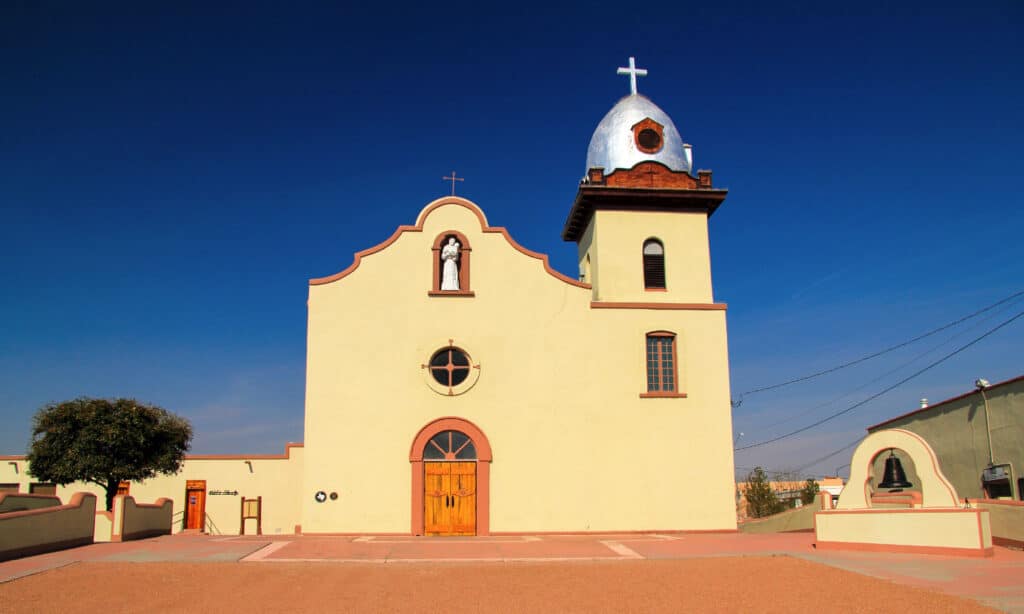
Ysleta’s mission church is one of the oldest continuously operated churches in Texas and is listed on the National Register of Historic Places.
©William Silver/Shutterstock.com
Today, Ysleta is considered a neighborhood or community within the larger city of El Paso. In addition, it is home to several historic landmarks including the Ysleta Mission, which was built in the 17th century. Despite being part of a larger city, Ysleta has maintained its cultural identity and continues to be an important part of the El Paso community.

The old bell in front of the Ysleta Mission.
©Bill Chizek/Shutterstock.com
2. San Antonio – 1718
San Antonio is the oldest city in Texas, founded by Spanish explorers in 1718. The city was established as a way station between the missions in East Texas and Mexico. Over time, San Antonio grew and became an important cultural, economic, and also military center. In addition, San Antonio is the second largest city in the state, with a population of over 1.5 million people (2021). The city has a rich history. It is known for its unique blend of cultures, as well as its vibrant tourism industry.
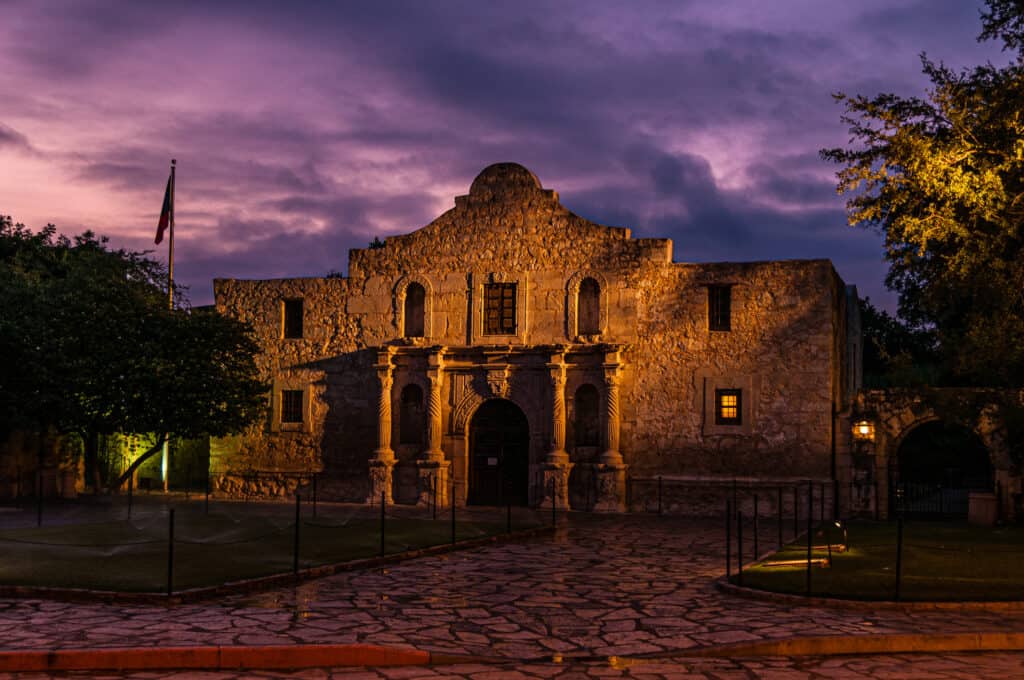
The Alamo lit up before sunrise in San Antonio, Texas.
©iStock.com/Greg Meland
San Antonio’s strong Hispanic influence is reflected in the city’s architecture, cuisine, and traditions. In addition, the city is home to several historic missions, including the Alamo. The Alamo is a former mission and the site of a pivotal battle during the Texas Revolution. The Alamo is one of the most visited tourist sites in Texas. It attracts millions of visitors from around the world each year.
The city is also known for its River Walk. The River Walk is a network of walkways along the San Antonio River. It is lined with restaurants, shops, and also entertainment venues. Other popular attractions are the San Antonio Museum of Art, the Tower of the Americas, and the San Antonio Zoo. The city is also a major center for healthcare, with several world-renowned medical institutions located in the area.

San Antonio is known for its River Walk, a network of walkways along the San Antonio River that is lined with restaurants, shops, and entertainment venues.
©Sean Pavone/Shutterstock.com
3. Goliad – 1749
Goliad is located in Southern Texas. The city is named after the Spanish presidio (fort), Fortaleza de Goliad. The fort was established in 1749 and played a significant role in the Texas Revolution.
In addition, one of the most notable attractions in Goliad is the Presidio La Bahia. The historic fort has been preserved as a museum and also a national historic landmark. Another popular attraction in Goliad is the Mission Espiritu Santo. It is a Spanish mission that is now part of the Goliad State Park and Historic Site. The mission offers a glimpse into the lives of the Spanish colonizers and the Native American communities that they worked with.
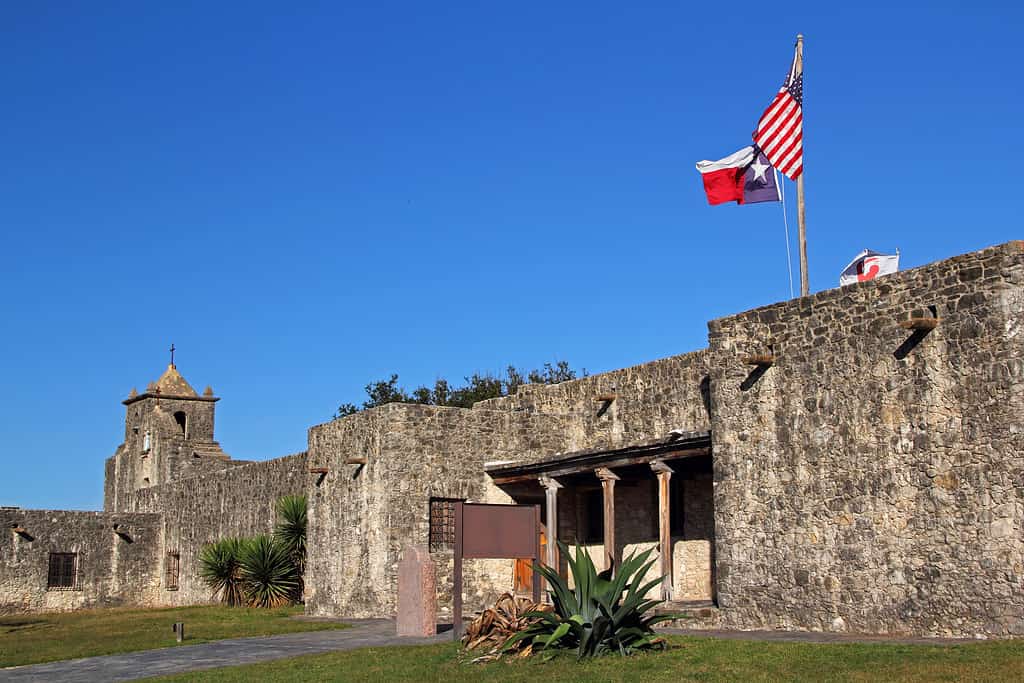
One of the most notable attractions in Goliad is the
Presidio La Bahia
.
©William Silver/Shutterstock.com
Today, Goliad is known for its charming downtown area. It is home to a variety of shops, restaurants, and historic buildings. In addition, the city hosts several festivals and events throughout the year. The Goliad Market Days is a popular outdoor market that features local vendors and artisans.
Goliad is a small city with a rich history and also has a strong sense of community. It is a captivating destination for visitors who are interested in learning about Texas history and experiencing small-town Texas culture.

Today, Goliad is known for its charming downtown area, which is home to a variety of shops, restaurants, and historic buildings.
©Roberto Galan/Shutterstock.com
4. Laredo – 1755
Laredo is one of the oldest cities in Texas. It was founded in 1755 by Don Tomás Sánchez. Laredo started out as a Spanish colonial settlement on the North bank of the Rio Grande, across from Nuevo Laredo, Mexico. The settlement was originally named San Agustín de Laredo. It served as a trading post and agricultural center for the surrounding region. Today, Laredo is a bustling city in Southern Texas with a population of over 260,000 people (2021). As a border town, Laredo has a rich cultural heritage that is strongly influenced by Mexican and Texan traditions. The city is known for its vibrant arts and culture scene, which includes museums, galleries, and festivals. Laredo offers everything from traditional Mexican music and dance to contemporary art and film.
Laredo is also a major center for international trade. Several major highways and rail lines connect the city to other parts of the United States, Mexico, and beyond. The city is home to the largest inland port on the US-Mexico border. International trade accounts for a significant portion of the local economy.
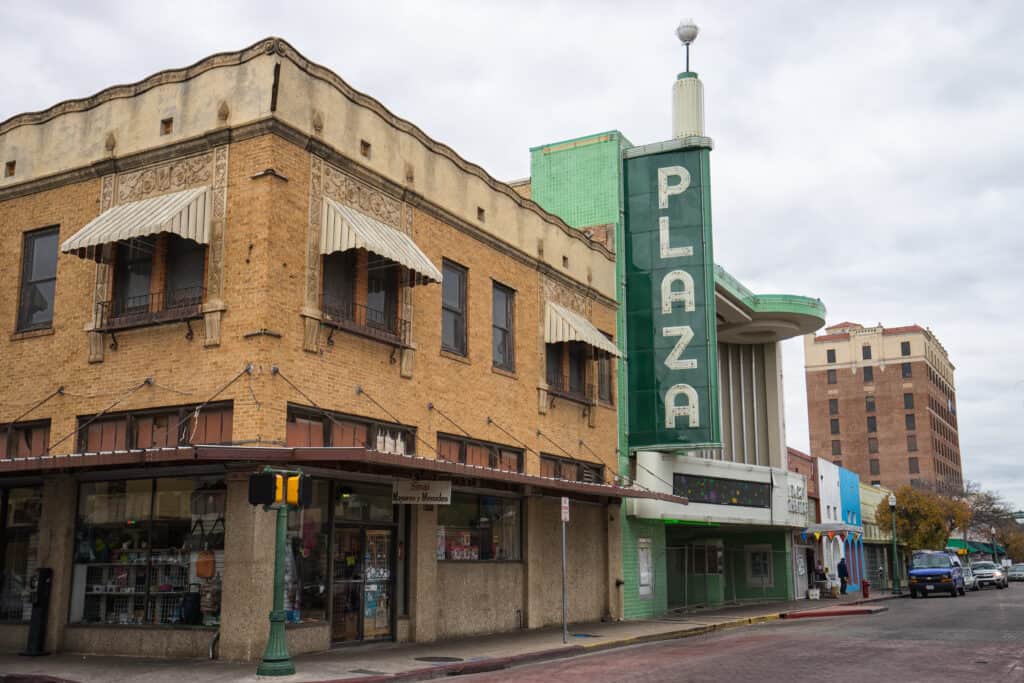
Laredo offers everything from traditional Mexican music and dance to contemporary art and film.
©Barna Tanko/Shutterstock.com
5. Nacogdoches – 1779
Nacogdoches is a city in East Texas and claims to be the oldest continuously inhabited city in the state. It was founded by Spanish colonizers in 1779. The city has a rich history and is known for its preservation of its historic architecture, as well as its many cultural attractions. Among the most notable attractions in Nacogdoches is the Sterne-Hoya House Museum and Library, which is a restored 19th-century home that offers visitors a glimpse into life during the early days of Texas. The city is also home to Stephen F. Austin State University.
Nacogdoches is surrounded by natural beauty, including the nearby Davy Crockett National Forest and the Angelina National Forest. The city is also known for its vibrant downtown area, which features boutique shops, restaurants, and art galleries. Nacogdoches hosts many festivals and events throughout the year, including the Texas Blueberry Festival and the Nine Flags Christmas Festival.

Nacogdoches is a city in East Texas and is the oldest continuously inhabited city in the state. It was founded by Spanish colonizers in 1779.
©iStock.com/Roberto Galan
6. Galveston – 1817
The establishment of Jean Lafitte’s smuggling operation on Galveston Island in 1817 makes it one of the oldest settlements in Texas. Although the island had been explored and mapped by the Spanish as early as the 18th century, there was no permanent settlement there until later in the 19th century, when the city of Galveston was founded. The Lafitte settlement on Galveston Island is a fine example of the lawless and often violent world of smuggling and piracy that characterized much of the Gulf of Mexico in the early 19th century.
Once founded (1836), Galveston quickly became an important port city for Texas, serving as a major center of trade and commerce. During the late 19th century, Galveston experienced a period of rapid growth and became known as the Wall Street of the Southwest due to its thriving financial sector.
A devastating hurricane struck the city in 1900. The storm, which was one of the deadliest natural disasters in U.S. history, killed thousands of people and caused extensive damage to the city. In the aftermath of the hurricane, Galveston was rebuilt with a new seawall and raised elevation, helping protect the city from future storms.
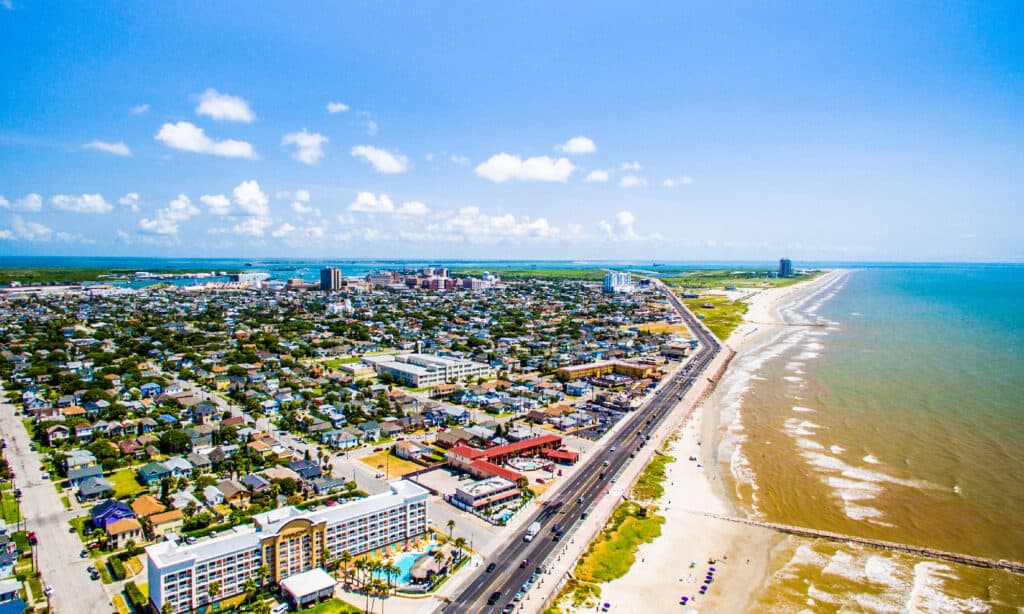
Galveston quickly became an important port city for Texas, serving as a major center of trade and commerce.
©iStock.com/Eric Overton
The Oil Industry
Galveston played an important role in the development of the oil industry in Texas. In 1901, a major oil discovery was made in nearby Beaumont, Texas, which helped establish Texas as a major center of oil production. Galveston continues to be a hub of oil refining and shipping. The Galveston oil spill of 2014 was a major environmental disaster that occurred when a barge collided with a cargo ship in the Houston Ship Channel, spilling nearly 170,000 gallons of heavy fuel oil into Galveston Bay. The spill negatively affected wildlife, as well as the local fishing and tourism industries. Cleanup efforts continued for months after the incident.
Today, Galveston is a popular tourist destination known for its beautiful beaches, historic architecture, and vibrant cultural scene. The city is home to several museums, including the Galveston Island Historic Pleasure Pier, which features amusement park rides and attractions, and the Moody Mansion, a historic home that has been preserved as a museum.

Moody Mansion is a historic home that is now a museum.
©Lina Xie/Shutterstock.com
7. Houston – 1836
Houston, Texas was founded on August 30, 1836, by two brothers named Augustus and John Allen. The city was named after Sam Houston, who was the first president of the Republic of Texas and played a key role in Texas’s fight for independence from Mexico. Houston’s early history was closely tied to the development of the Texas oil industry, which helped to fuel the city’s growth and economic prosperity. During the early 20th century, Houston emerged as a major center of oil production and refining, becoming known as the Energy Capital of the World.

Houston’s early history was closely tied to the development of the Texas oil industry, which helped to fuel the city’s growth and economic prosperity.
©United States Coast Guard, PA2 James Dillard, Public domain, via Wikimedia Commons – Original / License
Houston has also played a significant role in the development of the U.S. space program. The city is home to the Johnson Space Center, which is operated by NASA and has been the site of many historic space missions, including the Apollo moon landing program. Houston is also known for its cultural diversity and rich arts scene. The city is home to many museums, galleries, and performing arts venues, and it has a vibrant culinary scene that showcases a wide variety of cuisines.
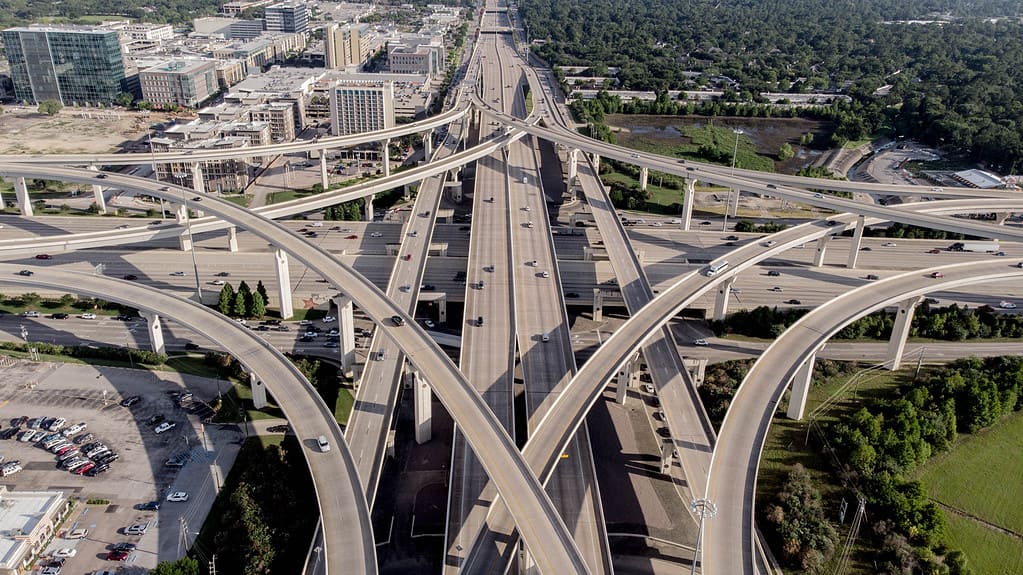
Sprawling growth contributed to the need for more roads and highways. Pictured: Ariel view of I-10 freeway intersecting with Beltway 8 in Houston Texas.
©omarhasan1/Shutterstock.com
8. Austin – 1839
Austin, Texas was founded on December 27, 1839. The city was named after Stephen F. Austin, who is known as the Father of Texas. Stephen F. Austin played a key role in the settlement and development of Texas during the 19th century. Austin was chosen as the capital of the Republic of Texas in 1839, and it became the capital of the state of Texas when Texas was annexed by the United States in 1845.
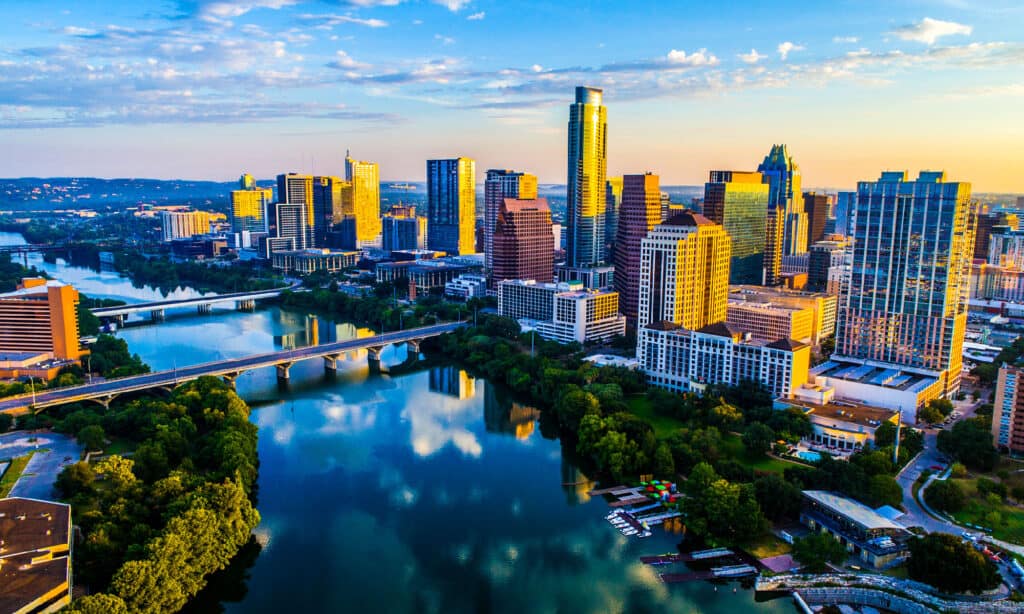
The Colorado River flows through Austin, Texas.
©iStock.com/RoschetzkyIstockPhoto
Austin Today
Today, Austin is a vibrant and diverse city that is known for its music scene, food culture, outdoor recreation, and high-tech industry. The city has a population of approximately one million people (2021) and is the capital of the state of Texas. One of the most notable features of Austin is its music scene. The city is home to many live music venues and festivals including South By Southwest (SXSW) and The Austin City Limits Music Festival. Austin has a long history of producing and nurturing talented musicians. The city is also known for its food culture, which features a diverse array of cuisines and many innovative chefs and restaurants.

Austin City Limits first aired on January 3, 1976!
©Lucas Beck/Shutterstock.com
Another key aspect of life in Austin is outdoor recreation. The city is situated in the heart of the Texas Hill Country and is surrounded by scenic parks, lakes, and natural areas. There are many opportunities for hiking, biking, swimming, and other outdoor activities. Austin has become a hub for the high-tech industry, with many technology companies and startups moving to the city. This has helped to drive economic growth and create many job opportunities in fields such as software development, engineering, and data analysis.
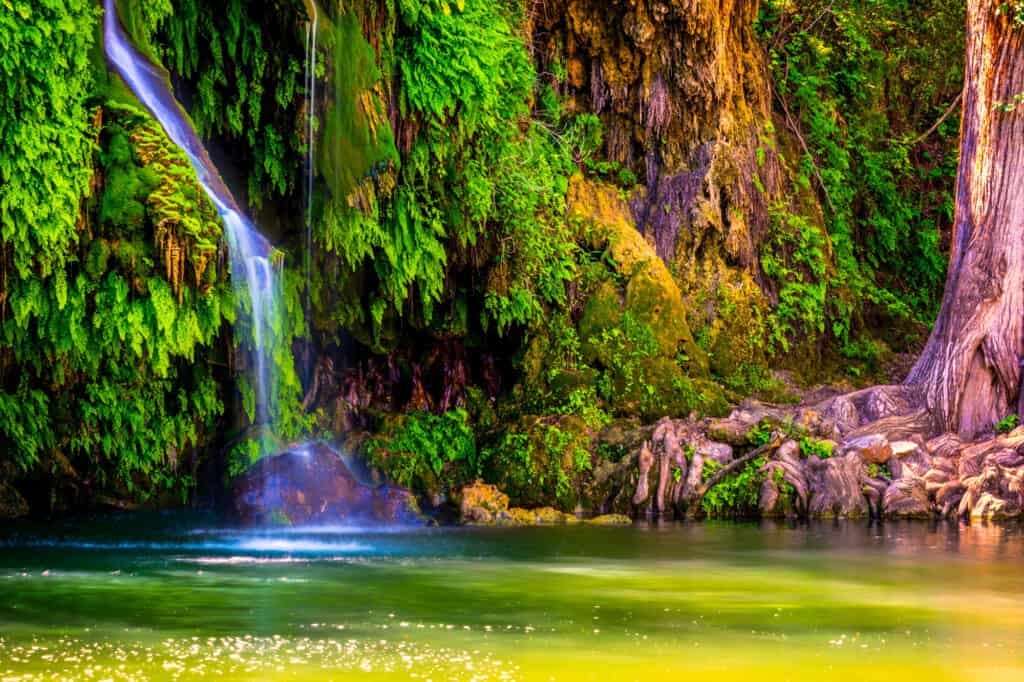
Austin is situated in the heart of the
Texas Hill Country
and is surrounded by scenic parks, lakes, and natural areas. Pictured: Krause Springs.
©JB Manning/Shutterstock.com
Thank you for reading! Have some feedback for us? Contact the AZ Animals editorial team.








